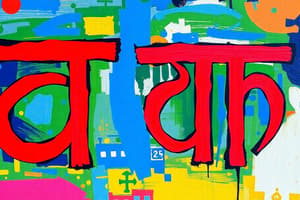Podcast
Questions and Answers
What is the typical word order used in Hindi grammar?
What is the typical word order used in Hindi grammar?
- Verb-Subject-Object
- Subject-Verb-Object
- Subject-Object-Verb (correct)
- Object-Subject-Verb
Which script is primarily used for writing Hindi?
Which script is primarily used for writing Hindi?
- Arabic script
- Cyrillic script
- Latin script
- Devanagari script (correct)
Which of the following is NOT a major dialect of Hindi?
Which of the following is NOT a major dialect of Hindi?
- Awadhi
- Marwari (correct)
- Maithili
- Bhojpuri
What type of words does Hindi include as loanwords?
What type of words does Hindi include as loanwords?
What challenge might learners face when studying Hindi?
What challenge might learners face when studying Hindi?
Which of the following authors is known for contributions to Hindi literature?
Which of the following authors is known for contributions to Hindi literature?
Which of these is a basic number in Hindi?
Which of these is a basic number in Hindi?
How is the language Hindi significant in festivals?
How is the language Hindi significant in festivals?
Flashcards are hidden until you start studying
Study Notes
Overview of Hindi
- Language Family: Indo-Aryan, part of the larger Indo-European family.
- Scripts: Primarily written in Devanagari script.
- Status: Official language of India and one of the 22 scheduled languages.
Linguistic Features
- Phonetics: Contains 11 vowel sounds and 33 consonant sounds.
- Grammar:
- Word Order: Typically Subject-Object-Verb (SOV).
- Gender: Nouns are either masculine or feminine.
- Tenses: Present, past, and future; aspects are indicated using verbs.
- Postpositions: Functions similarly to prepositions in English, appearing after nouns.
Dialects
- Major dialects include:
- Bhojpuri
- Awadhi
- Maithili
- Rajasthani Hindi
- Regional variations exist in pronunciation and vocabulary.
Vocabulary
- Loanwords: Includes words borrowed from Sanskrit, Persian, Arabic, and English.
- Common Terms:
- Greetings: "Namaste" (hello), "Shukriya" (thank you).
- Basic Numbers: 1 (ek), 2 (do), 3 (teen), 10 (das).
Cultural Significance
- Literature: Rich tradition of poetry and prose, with notable authors like Premchand and contemporary writers such as Kamala Das.
- Media: Widely used in films (Bollywood), music, and television.
- Festivals: Language is a medium of expression in festivals like Diwali, Holi, and others.
Learning Resources
- Textbooks: Available for beginner to advanced levels focusing on grammar, vocabulary, and conversation.
- Online Resources: Language learning apps and websites.
- Communities: Language exchange programs and Hindi-speaking communities for practice.
Challenges
- Dialects & Variants: Understanding regional dialects can be difficult for learners.
- Script: Learning Devanagari can be challenging for non-native speakers.
Conclusion
- Hindi is a vibrant and dynamic language with rich historical and cultural roots, making it an essential language for communication in India and among the Indian diaspora globally.
Hindi: An Overview
- Hindi is an Indo-Aryan language, part of the Indo-European language family.
- Primarily written in Devanagari script.
- Official language of India
- One of the 22 scheduled languages in India.
Linguistic Features
- Contains 11 vowel sounds and 33 consonant sounds.
- Typical word order is Subject-Object-Verb (SOV).
- Nouns are either masculine or feminine.
- Tense system includes present, past, and future tenses indicated by verbs.
- Uses postpositions instead of prepositions.
Dialects
- Major dialects include Bhojpuri, Awadhi, Maithili, and Rajasthani Hindi.
- Dialects have regional variations in pronunciation and vocabulary.
Vocabulary
- Includes loanwords from Sanskrit, Persian, Arabic, and English.
- Common greetings include "Namaste" (hello) and "Shukriya" (thank you).
- Basic numbers include 1 (ek), 2 (do), 3 (teen), and 10 (das).
Cultural Significance
- Rich tradition of poetry and prose, with notable authors like Premchand and contemporary writers like Kamala Das.
- Widely used in Bollywood films, music, and television.
- Language is a central part of festivals like Diwali and Holi
Learning Resources
- Textbooks for various levels, from beginners to advanced.
- Online resources include language learning apps and websites.
- Language exchange programs and Hindi-speaking communities for practice.
Challenges
- Understanding different dialects can be a challenge for learners.
- Learning the Devanagari script can be difficult for non-native speakers.
Conclusion
- Hindi is a dynamic and vibrant language, deeply rooted in history and culture.
- It is essential for communication in India and among the Indian diaspora worldwide.
Studying That Suits You
Use AI to generate personalized quizzes and flashcards to suit your learning preferences.




